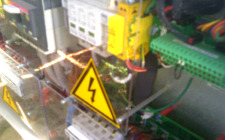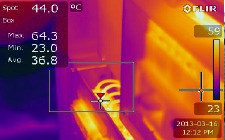Thermal imaging camera detects solar power plant problems in Punjab
Monday, 09 December, 2013
When solar energy panels threaten to fail, defects will usually generate heat. Carlill Energy has successfully adopted the use of thermal imaging cameras to detect and identify problems with photovoltaic (PV) cells, junction boxes and grid network connections at a very early stage.
Punjab, India, is endowed with a vast potential of solar energy, with over 300 days of sunshine per year. Across the state, Carlill Energy has already installed a solar plant capacity of 1.5 MW. The latest plant was commissioned in February 2012 in Muktsar (Eastern Punjab), in conformance with the Punjab Energy Development Agency (PEDA) directives.
After having an issue with a failed diode box in the recent past, Carlill Energy started to look for a solution that was able to provide an advance warning. Based on such a warning, the company was hoping to take precautionary measures and prevent incidents with failed diode boxes from happening again. After thorough research of the marketplace and based on feedback from industry professionals, it was decided to go for a FLIR thermal imaging camera.
FLIR’s distributor, M/s Industrial Agencies, based in Chandigarh, India, provided Carlill Energy with a FLIR i7 thermal camera. M/s Industrial Agencies also took care of training the Carlill Energy maintenance staff. During the training, three major hot spots in junction boxes were observed. According to the maintenance staff, the failure of these connections could have hampered the plant’s power generation.


The management team of Carlill Energy was enthusiastic about the performance of the FLIR i7 camera, saying, “We should have bought this equipment last year when we were actually commissioning this plant.” Today, the company uses three FLIR i7 cameras. Next to the identification of issues with diode boxes, Carlill Energy is also using the FLIR i7 thermal imaging camera for the identification of issues with PV cells and the grid network connections/terminations.
According to Satnam Singh, maintenance manager at Carlill Energy, the FLIR i7 thermal imager will help identify problematic areas and, as a result, ensure flawless supply of electricity to the grid. In addition, this will increase the overall return on investment of the company for this plant.
The small and light thermal imaging camera is easy to use and requires no former experience, as it has been designed for entry-level users. It is as simple as ‘point-shoot-detect’ to obtain high-quality thermal images that will immediately give the user the thermal information needed.
The product produces instant, point-and-shoot JPEG thermal imagery that carries all required temperature data and can be stored internally or externally, sent and analysed. The unit only weighs 365 g and is easy to store in a belt pouch. FLIR i-Series thermal imaging cameras withstand a 2 m drop, are watersplash-proof and IP43-rated.
Carlill Energy also opted for the FLIR Tools software, which has been designed to quickly import, edit and analyse images to turn them into professional PDF inspection reports, ready to print or email.
A touch of sugar could help upcycle carbon dioxide into fuels
A new catalyst made from table sugar could have the power to upcycle carbon dioxide...
Heat recovery could save money and the environment
Up to 96% of the drive energy supplied to a compressor is available for reuse — this is...
Dirty dancing across a new energy landscape
The real-time balancing of electricity generation (supply) and demand is like a dynamic dance and...











